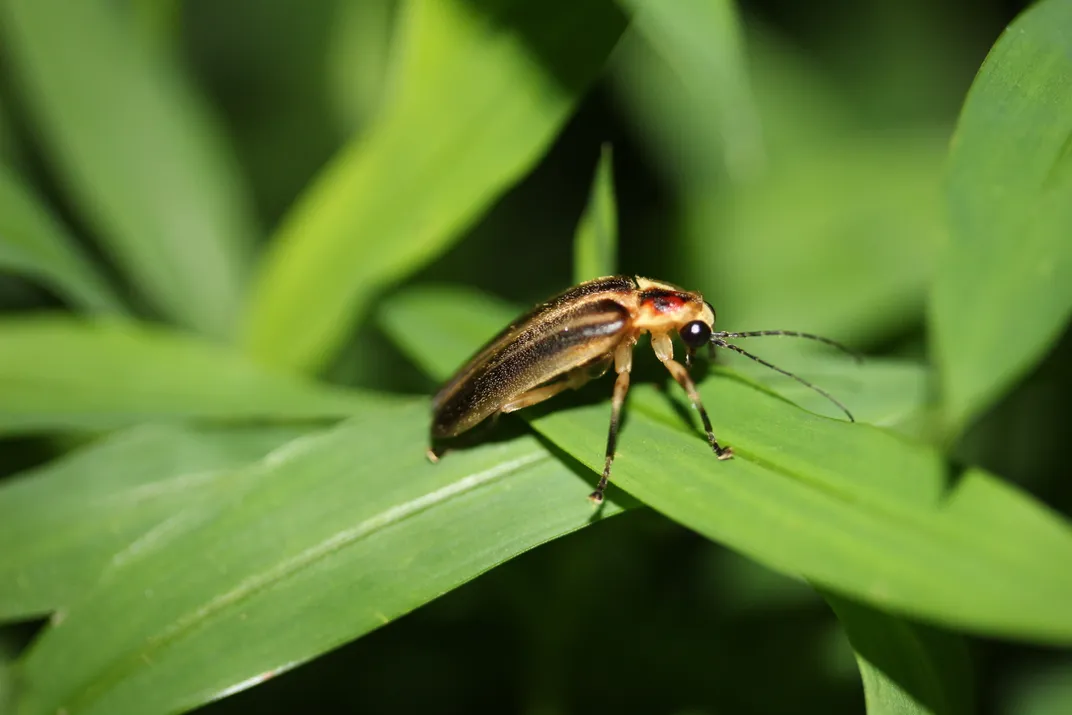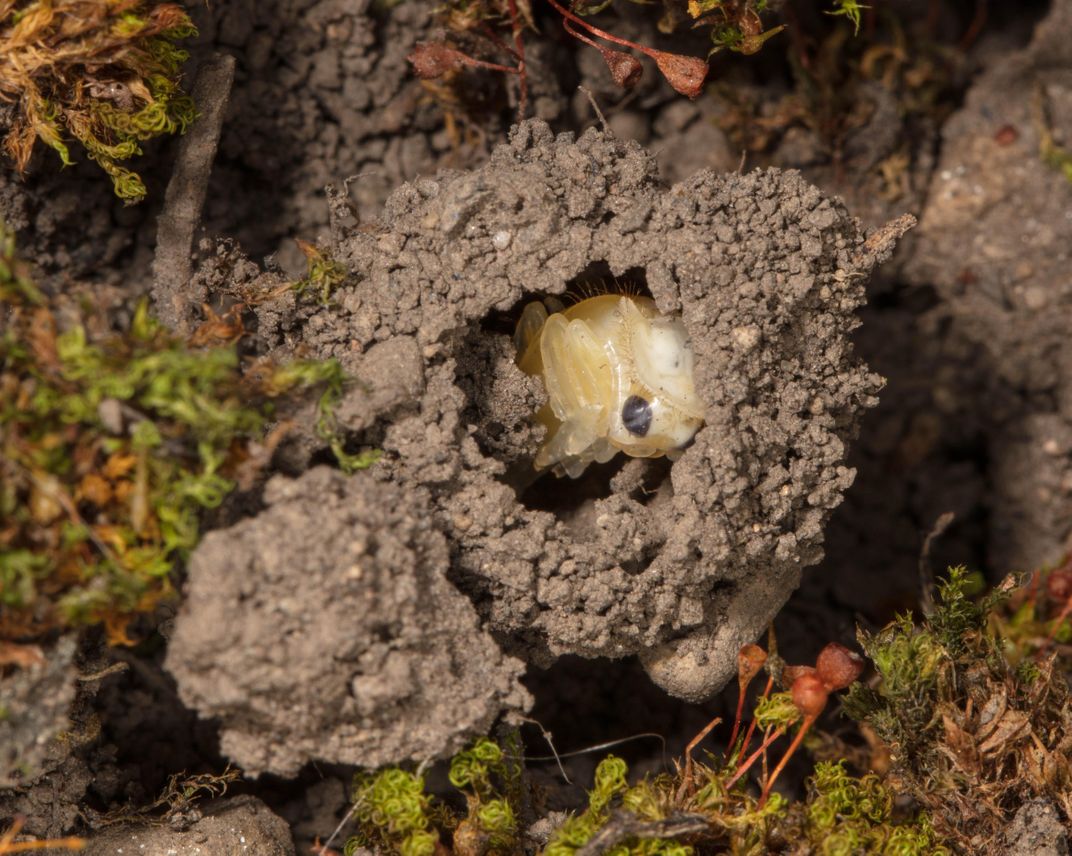Illuminating the Secret Language of Lightning Bugs
For these light-up lovers, each flash in the night could mean sex or death
/https://tf-cmsv2-smithsonianmag-media.s3.amazonaws.com/filer/1b/c1/1bc11d90-fd5c-4bc5-8502-dbc990879638/fhdpbx.jpg)
If you're deep in the Southern Appalachian Mountains around dusk and spy a hazy blue circle crawling across the ground, take note: you just might be in the presence of a ghost. A blue ghost firefly, that is.
When most of us think of fireflies (or lightning bugs, as we call them in the North), we picture yellow and green-flashing orbs against a darkening summer sky. But the truth is, there’s an astonishing amount of diversity among these bioluminescent beetles. Over 2,000 species of lightning bug sparkle and flicker on this Earth, with more than 125 species living in the United States. And each one speaks its own language.
Lightning bug lamps can glow yellow, orange or, as is the case with the ghosts, even shades bordering on electric blue. They can appear as single blinks or long, glowing trails. Some fireflies will flicker when threatened by a predator or caught in a spiderweb. Others light up to compete with rivals or after they’ve been rejected by a suitor. Some females are completely dark, while others offer flickers to let males know they’re on the market.
For the last 26 years, Lynn Faust has been working to catalog and decipher the bioluminescent Morse Code each species flickers out come spring and summer. “Lightning bug flashes are works of art,” says Faust, a naturalist who recently penned the definitive book on the topic, Fireflies, Glow-worms, and Lightning Bugs, published by University of Georgia Press. “It blows my mind how they evolved these things.”
Take Photinus pyralis, one of the largest and most recognizable fireflies in the eastern U.S. On warm summer evenings from mid-June to early July, the males of this species can be found floating about your backyard as dusk falls, usually about waist-high. And while many closely related insect species can only be told apart by dissection and close-up examination of their genitalia, you can identify this one without ever laying hands on it. Just look for the leisurely scrawled "J" shape their butts drag across the darkening sky. That shape has also earned them the nickname "Big Dippers."
Elsewhere in firefly pageantry, Photuris pennsylvanica can be recognized across the Mid-Atlantic states from its quick, yellow-green flash followed by a longer pulse that lasts one to three seconds. Faust calls this firefly the "Dot-dash." The "Marsh Diver," Pyractomena palustris, likes to light up for several milliseconds before diving into wetlands grass. It then repeats the maneuver three seconds later. Look for them as far north as Pennsylvania and south to Tennessee.
For Phausis reticulata, which is the Blue Ghost’s less-spooky official title, the name of the game is low and slow. These males sport a bluish-green lamp that they can leave on for a minute or more as they hover near the ground looking for a female. (By and large, firefly displays are about finding that special someone.) Sometimes, the males will even do a move called “spotlighting,” where they point their lamp at the ground while flying in small circles. This can look particularly eerie, says Faust, because you see these lights moving across the ground but not the lightning bug.

In her book, Faust writes of a particularly memorable night in the Cumberland Mountains of Tennessee where there were so many blue ghosts lighting up about 18 inches off the ground that it looked like “an earthbound aurora borealis.” The horse she was riding seemed confused by the whole affair, and kept trying to step up onto the layer of light they created.
Interestingly, Faust says each species’ display is not set in stone, but can change slightly depending on the time of the year, the time of night and the temperature of the air. Warmer weather, for instance, means the displays get a little extra pep in their step. Likewise, colder temperatures have a slow-motion effect. And when temperatures plunge below 50 degrees Fahrenheit, even the horniest of fireflies can’t muster the strength to get turned on.
While flashing is typically associated with males, one exception is the females of the Photuris versicolor complex. Most females that flash have a lamp that’s “shorter, paler, and simpler” than the males, according to Faust. But these so-called femme fatales can perform an array of robust flashes meant to mimic the come-hither calls of females from other firefly species. As it turns out, they aren’t just trying to get a date—they’re looking for (literal) fresh meat. Desperate to mate, males soar in to investigate what looks like an amorous female of their own species, and are promptly devoured.
Sometimes, femme fatales will even take to the skies and hunt blinking males on-the-wing. This is known as hawking, and best observed while blasting Highway to the Danger Zone from some earbuds. Femme fatales have also been known to filch other fireflies that have become trapped in spider webs.
This predatory behavior is particularly interesting, because fireflies don’t usually eat during the few weeks they spend as adults before flickering out for good. In fact, a firefly spends the vast majority of its life (one to two years) as a ravenous little larvae known as a glow-worm. These tiny, glowing predators prowl about the underbrush hunting for worms, slugs, snails and anything else they can seize with their mandibles and inject with a paralysis-inducing venom. (Fortunately, glow-worms are too teensy to bite us humans.)
Why all the ravenous ladies, then? Well, many firefly species possess chemical compounds that make them unappealing to predators. This makes sense, given that lightning bugs are relatively slow-flying insects that flit about with the equivalent of a neon billboard on their butts. Without chemical weapons, they'd would be easy pickings for bats, birds, and a whole host of other predators. And while femme fatales have been found to produce at least some of these compounds on their own, Faust and her colleagues believe they acquire others through acts of cannibalism. The females then pass these defenses onto their eggs and larvae.
Unfortunately for the fellas, femme fatales don’t just eat rival species. Potential mates are also on the menu. A femme fatale will even break off an active mating session to turn around and wolf down her paramour, mid-coitus. (And you thought black widows were jerks.) Perhaps this is why males in this genus possess two “arms” on either side of their aedeagus—which is what we call an insect’s penis—that remain outside the female while mating. It’s suspected that these arms act as an Incoming Cannibalism Alarm System that alerts the male if the female should start to shift beneath him.

For all we now know about the language of lightning bug optics, plenty more is out there just waiting to be illuminated. For instance, there are some Photuris fireflies that can only be found in a few far-flung swamps, and appear to be variations of a new species. Faust refers to the ones nearest her home in Eastern Tennessee as the "Loopy 5s." These fireflies flash rapidly for five to seven seconds before ending with a flourish and then disappearing for 11 seconds, only to repeat the flash train elsewhere.
In fact, the Loopy 5s are so different from other fireflies, and so seldom seen, that at one point Faust started to think that she’d imagined them. That is, until she called up a scientist she refers to affectionately as Dr. Photuris—James E. Lloyd, professor emeritus at the University of Florida.
Lloyd has been studying lightning bugs for sixty-some years, and he and Faust often bounce sightings and identifications off each other. A few years ago, Faust called Lloyd to tell him about the Loopy 5s and he stopped her mid-sentence and said he’d seen a very similar flash train in a North Carolina swamp back in the 1960s. He likened the buildup and flourish to a sneeze—ah, ah, ah, ah, ah, CHOOOOOO!
Unfortunately, the next time Lloyd went back to the site of the swamp sneezers, bulldozers were busy converting the wetlands into a golf course. Faust’s Tennessee population of Loopy 5s may also be under threat, as their wetlands were recently slated to become a housing plan (before being spared by the economic downturn). If the project were to ever go through, and the Loopy 5s eradicated, it would mean only one site for this potentially new species would remain—the cedar swamp found in Mississippi’s Wall Doxey State Park.
Faust has certainly seen her fair share of firefly species, having traveled as far as Southeast Asia to search for their flashes. (In fact, she’s created an amazing illustrative chart that depicts the primary courtship flashes for many of the most common firefly species in the U.S., but you’ll have to buy the book to get it!) But there’s one flasher she still longs to lay eyes upon: the Pleotomus davisii, also known as "Davis’s Oddballs." This species is rarely seen, but there are historical records of it existing from the Cumberland Gap on down to the Great Smoky Mountains.
As far as fireflies go, Faust admits that the Oddballs aren’t that sexy. The males are mostly dark with feathery antennae. The females don’t fly; instead, they resemble large, glowing grubs that do most of the flashing. As a result, many of the specimens we have of this insect are of males that had been attracted to artificial sources of light.
So every night, Faust sets up a light trap in her backyard as the dusk gives way to dark—a candle in the window, if you will. One day, she hopes, an oddball will fly up to greet her.
“Other people have seen them,” says Faust, “and I have haunted those woods, but I have never seen one alive.”